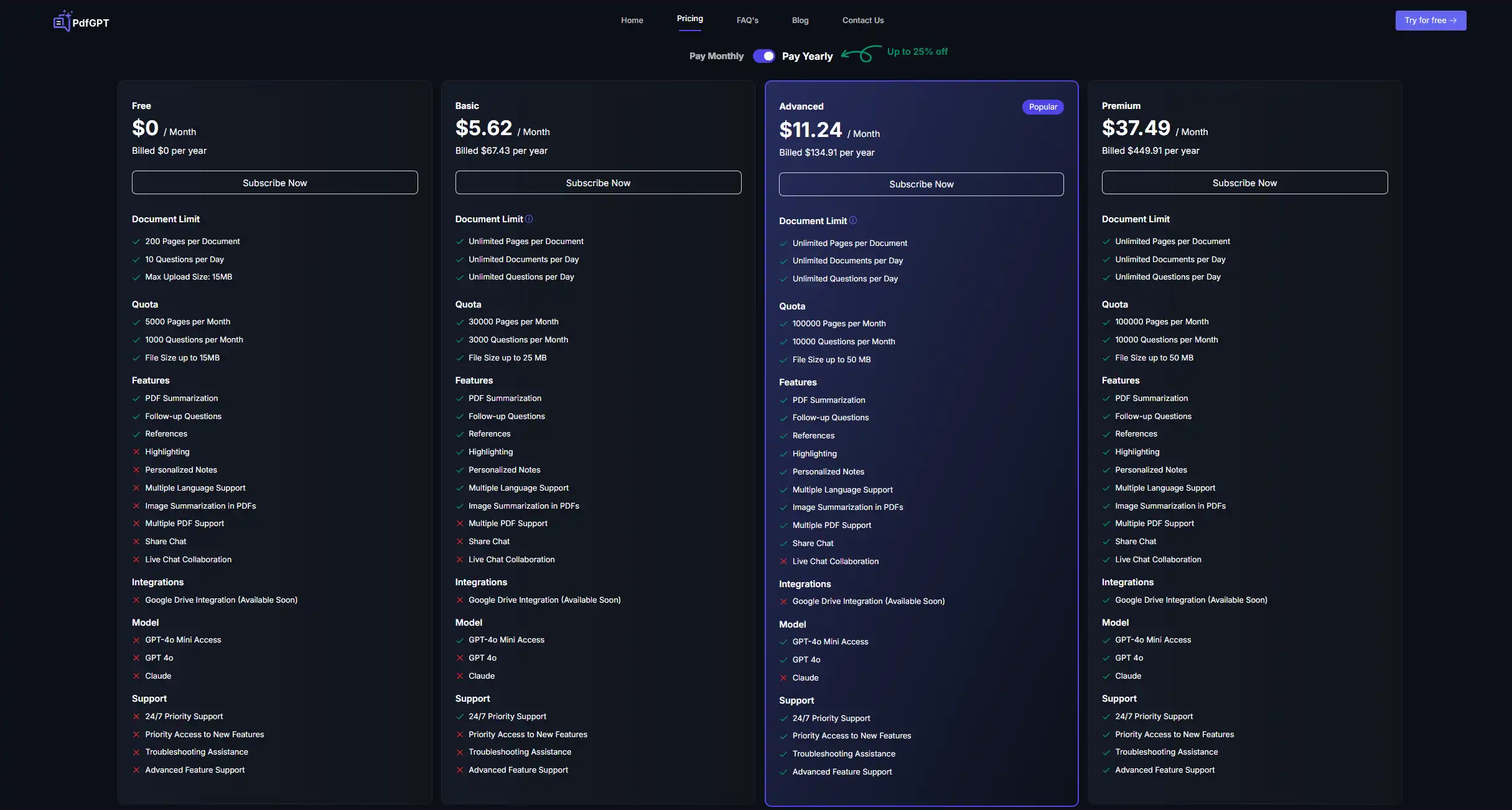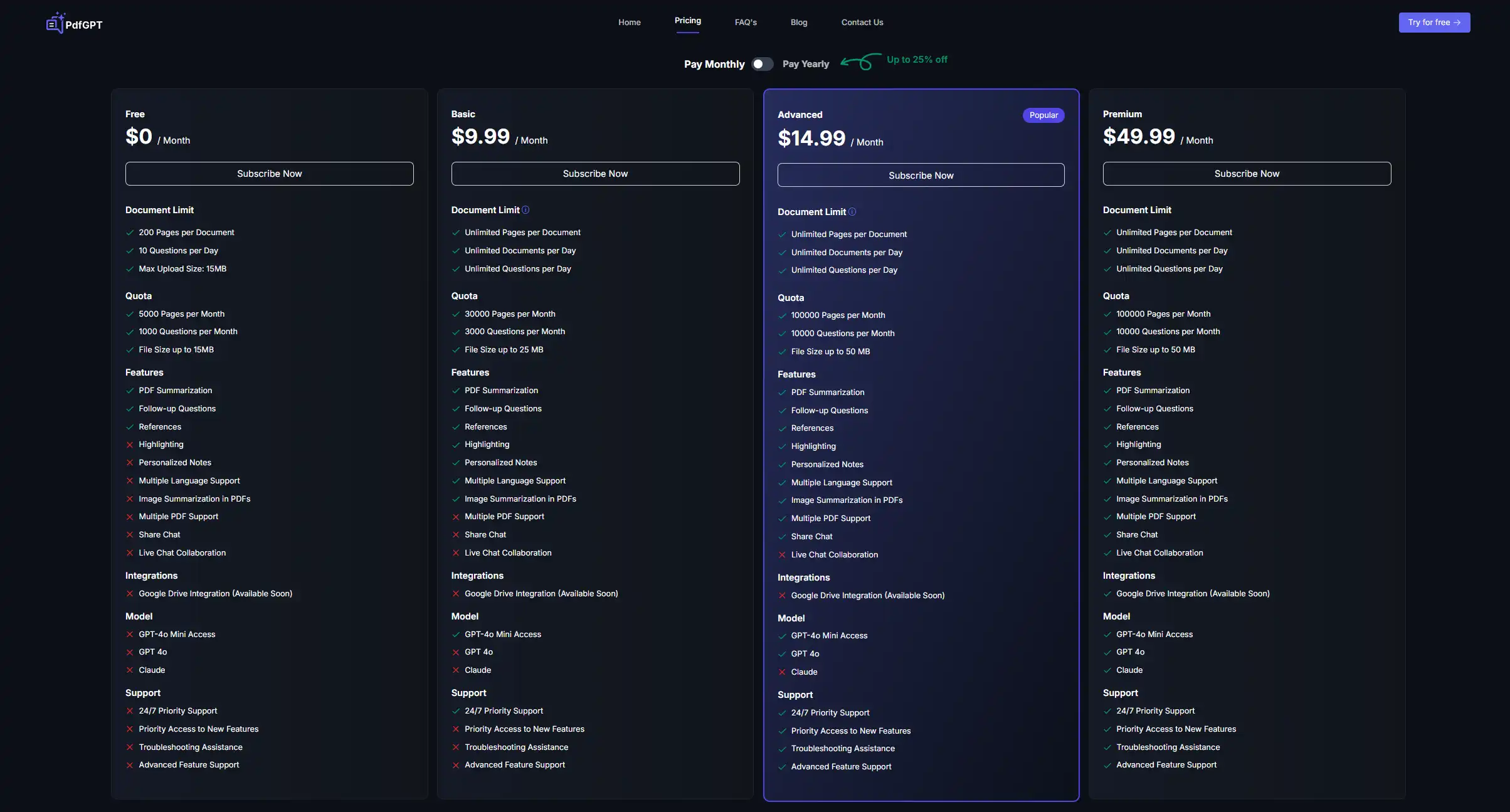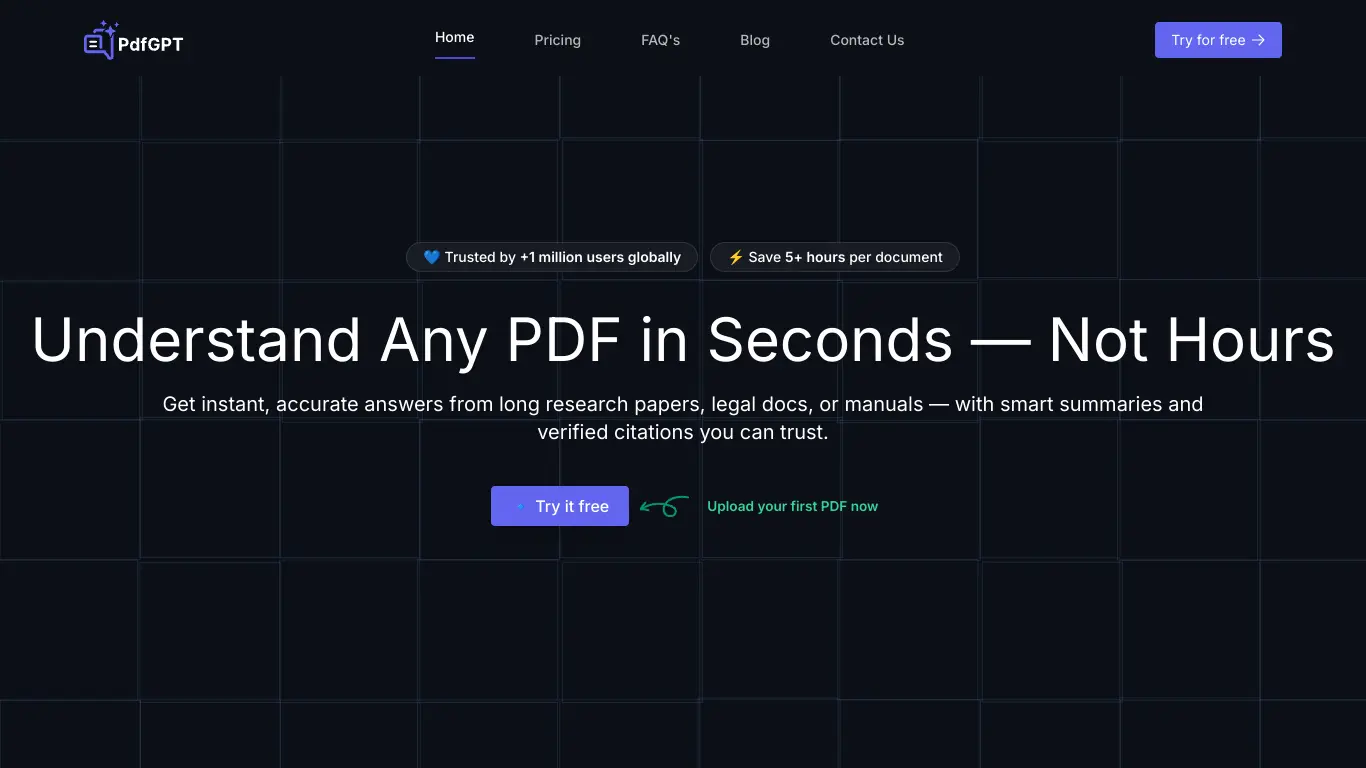PDFGPT.io transforms how you interact with PDFs, enabling natural language queries to quickly extract information from documents.
Extracting valuable insights from lengthy PDFs can feel like searching for a needle in a haystack. Whether you’re a student drowning in research papers, a professional tackling technical documents, or a researcher sifting through studies, the challenge is universal: how do you quickly find what you need without spending hours reading? This is where AI-powered PDF tools promise to revolutionize our relationship with documents—and PDFGPT.io stands at the forefront of this transformation.
Introduction to PDFGPT.io
What is PDFGPT.io and its Purpose?
PDFGPT.io is an innovative AI-powered tool designed to transform how users interact with PDF documents. At its core, it functions as a specialized chatbot that can read, understand, and answer questions about the content of your PDFs. Unlike traditional PDF readers that simply display content, PDFGPT.io actually comprehends the information within your documents, allowing you to have natural conversations about the material.
The primary purpose of PDFGPT.io is to eliminate the tedious process of manually searching through long documents. Instead of skimming pages or using basic keyword searches, users can simply ask questions in plain language and receive relevant, contextual answers extracted directly from their PDFs.
Who is PDFGPT.io Designed For?
PDFGPT.io caters to a diverse audience with varying document-related needs:
- Students: Can quickly extract key information from textbooks, research papers, and course materials
- Researchers: Can efficiently analyze scientific papers and data-heavy documents
- Business professionals: Can extract insights from reports, contracts, and technical documentation
- Legal professionals: Can navigate complex legal documents and quickly find relevant clauses
- Knowledge workers: Anyone who regularly works with information-dense PDFs
Essentially, if you find yourself regularly working with PDFs and wishing for a faster way to extract information, PDFGPT.io was designed with you in mind.
Getting Started with PDFGPT.io: How to Use It
Getting started with PDFGPT.io is remarkably straightforward:
- Visit the website: Navigate to https://pdfgpt.io
- Upload your PDF: Select and upload the document you want to analyze (the free plan allows PDFs up to 10MB)
- Wait for processing: The AI will analyze and understand your document
- Ask questions: Type natural language questions about your document in the chat interface
- Receive answers: Get accurate responses based on the content of your PDF
The seamless interface requires no special training or technical knowledge. If you can ask a question, you can use PDFGPT.io effectively.
PDFGPT.io’s Key Features and Benefits
Core Functionalities of PDFGPT.io
PDFGPT.io offers several powerful features that set it apart from standard PDF tools:
- Natural Language Processing: Ask questions in everyday language and receive coherent, contextual answers.
- Content Summarization: Request summaries of entire documents or specific sections to quickly grasp main points.
- Information Extraction: Pull specific data points, statistics, or quotations from your documents with simple queries.
- Multi-document Analysis: Premium users can upload multiple PDFs and ask questions that span across documents, allowing for comparative analysis.
- Citation Support: The tool references specific pages or sections when providing answers, helping you verify information and cite sources properly.
- Contextual Understanding: Unlike basic search functions, PDFGPT.io understands the context of information within your document, providing more relevant answers.
Advantages of Using PDFGPT.io
The benefits of incorporating PDFGPT.io into your document workflow include:
- Time Efficiency: Reduce hours of reading to minutes of conversation with your documents.
- Improved Comprehension: Get clear explanations of complex concepts contained in technical documents.
- Enhanced Productivity: Focus on applying information rather than hunting for it.
- Accuracy: Receive precise answers drawn directly from your documents rather than general web searches.
- Convenience: Access your documents’ content through an intuitive chat interface from any device with internet access.
- Privacy Focus: Your documents remain private and secure, with options to delete data after sessions.
Main Use Cases and Applications
PDFGPT.io excels in various practical scenarios:
Academic Research 📚
- Quickly finding relevant passages in research papers
- Extracting key statistics and findings from studies
- Understanding complex theoretical concepts in textbooks
Business Intelligence 💼
- Analyzing lengthy market reports for actionable insights
- Extracting specific data points from financial documents
- Reviewing contracts and legal documents for important clauses
Professional Development 🔍
- Digesting technical documentation and manuals
- Learning new concepts from educational materials
- Staying updated on industry white papers and reports
Content Creation ✍️
- Researching information for articles, blog posts, or books
- Fact-checking from original source documents
- Finding quotable material from primary sources
Exploring PDFGPT.io’s Platform and Interface
User Interface and User Experience
PDFGPT.io offers a clean, intuitive interface designed for ease of use:
The platform features a minimalist design with two main components:
- Document Upload Area: A simple drag-and-drop zone where users can upload their PDFs, with clear indicators of file size limitations and supported formats.
- Chat Interface: A familiar messaging-style interface where users ask questions and receive answers, with options to reference specific parts of the document.
The design prioritizes functionality while minimizing distractions, allowing users to focus entirely on their interaction with the document. The response times are impressively quick, with most queries answered within seconds, depending on document size and complexity.
User controls are straightforward, with options to:
- Clear chat history
- Download conversation logs
- Adjust AI response settings
- Switch between documents (premium feature)
Platform Accessibility
PDFGPT.io is designed with accessibility in mind:
- Device Compatibility: The web-based platform works across desktops, laptops, tablets, and mobile devices.
- Browser Support: Functions smoothly on all major browsers including Chrome, Firefox, Safari, and Edge.
- No Installation Required: Being entirely web-based means no downloads or installations.
- Responsive Design: The interface adjusts appropriately to different screen sizes.
While primarily English-based, the tool can process documents in multiple languages, though response quality may vary for non-English content. This makes it accessible to a global audience with diverse language needs.
PDFGPT.io Pricing and Plans
Subscription Options
PDFGPT.io offers a tiered pricing structure to accommodate different usage needs:


The most significant dividing line between free and paid tiers is the query limit and file size restrictions, which can be important constraints for regular users.
PDFGPT.io Reviews and User Feedback
Pros and Cons of PDFGPT.io
Based on user reviews and platform analysis, here’s a balanced assessment of PDFGPT.io’s strengths and limitations:
Pros:
- ✅ Exceptional accuracy in extracting relevant information
- ✅ Intuitive, user-friendly interface requiring minimal learning curve
- ✅ Impressive contextual understanding of document content
- ✅ Helpful citation feature that references specific pages
- ✅ Strong privacy policies with options to delete uploaded documents
- ✅ Responsive customer support team
Cons:
- ❌ Free plan limitations can be restrictive for frequent users
- ❌ Occasional processing delays with very large documents
- ❌ Complex tables and charts sometimes not fully interpreted
- ❌ Limited advanced formatting options for exported conversations
- ❌ No offline functionality option
User Testimonials and Opinions
Users across various fields have shared their experiences with PDFGPT.io:
“As a PhD student, PDFGPT.io has been a game-changer for literature reviews. I can upload research papers and quickly extract methodologies and findings without reading every page.” – Sarah K., Doctoral Researcher
“Our legal team uses this to review contracts and quickly identify potentially problematic clauses. It’s saved us countless hours of manual review.” – Michael T., Corporate Counsel
“The ability to ask follow-up questions and get the AI to explain complex concepts from technical manuals has made onboarding new team members much more efficient.” – Anita R., Technical Team Lead
“I appreciate the free tier for occasional use, but hit the limits quickly. Worth upgrading if you work with PDFs regularly.” – David L., Marketing Consultant
The consensus among users is that while the tool has some limitations, particularly in the free tier, the time-saving benefits and accuracy of information extraction deliver significant value for regular PDF users.
PDFGPT.io Company and Background Information
About the Company Behind PDFGPT.io
PDFGPT.io was developed by a team of AI specialists and natural language processing experts who recognized the growing need for more intelligent document interaction tools. The platform leverages advanced language models similar to those powering ChatGPT but specifically optimized for document analysis and information retrieval.
The company maintains a strong focus on:
- Technological Innovation: Regular updates improve the AI’s understanding capabilities and processing efficiency.
- User Privacy: Clear policies about document handling, with options for automatic deletion and data protection measures.
- Accessibility: Continuous improvements to make advanced AI document analysis available to non-technical users.
- Educational Applications: Special focus on developing features beneficial to students and researchers.
While relatively new to the market compared to some document management solutions, PDFGPT.io has quickly gained traction among knowledge workers who regularly deal with information-dense PDFs.
PDFGPT.io Alternatives and Competitors
Top PDFGPT.io Alternatives in the Market
Several other tools offer similar PDF analysis capabilities with varying features and focus areas:
- ChatPDF (https://www.chatpdf.com): Another popular PDF AI chat tool with slightly different pricing tiers.
- PDF.ai (https://pdf.ai): Focuses on enterprise-level document analysis with API-first approach.
- Humata AI (https://www.humata.ai): Offers multi-document analysis with academic research focus.
- AskYourPDF (https://askyourpdf.com): Emphasizes document summarization capabilities.
- Mendable (https://mendable.ai): Specializes in technical documentation and knowledge base analysis.
PDFGPT.io vs. Competitors: A Comparative Analysis
Here’s how PDFGPT.io stacks up against its main competitors:
| Feature | PDFGPT.io | ChatPDF | PDF.ai | Humata AI |
|---|---|---|---|---|
| Free Plan | ✅ (10MB, 20 queries) | ✅ (limited) | ❌ | ✅ (very limited) |
| Max File Size | 50MB (Pro) | 40MB | 100MB | 50MB |
| Multiple Files | ✅ (paid plans) | ✅ (paid) | ✅ | ✅ |
| Citation | ✅ | ✅ | ✅ | ✅ |
| API Access | ✅ (Enterprise) | ❌ | ✅ | ✅ (Enterprise) |
| UI Friendliness | ⭐⭐⭐⭐⭐ | ⭐⭐⭐⭐ | ⭐⭐⭐ | ⭐⭐⭐⭐ |
| Accuracy | ⭐⭐⭐⭐⭐ | ⭐⭐⭐⭐ | ⭐⭐⭐⭐⭐ | ⭐⭐⭐⭐ |
| Starting Price (Paid) | $9.99/month | $8/month | $16/month | $12.99/month |
PDFGPT.io distinguishes itself through an excellent balance of user-friendly interface, accuracy in responses, and reasonable pricing tiers. While competitors may excel in specific areas (like PDF.ai’s larger file size limits or Humata’s research-focused features), PDFGPT.io offers the most well-rounded solution for general PDF interaction needs.
PDFGPT.io Website Traffic and Analytics
Website Visit Over Time
PDFGPT.io has experienced significant growth in website traffic since its launch, reflecting increasing interest in AI-powered document tools:
| Quarter | Estimated Monthly Visitors | Growth |
|---|---|---|
| Q1 2023 | 75,000 | Baseline |
| Q2 2023 | 120,000 | +60% |
| Q3 2023 | 195,000 | +62.5% |
| Q4 2023 | 285,000 | +46.2% |
| Q1 2024 | 410,000 | +43.9% |
This consistent growth pattern suggests strong market validation and increasing adoption of the platform.
Geographical Distribution of Users
PDFGPT.io serves a global audience, with user concentration reflecting both English-language markets and knowledge economy hubs:
- United States – 35%
- United Kingdom – 12%
- Canada – 9%
- Australia – 7%
- India – 6%
- Germany – 5%
- France – 4%
- Singapore – 3%
- Netherlands – 2%
- Other countries – 17%
This distribution highlights PDFGPT.io’s strength in academic and professional markets across North America, Europe, and the Asia-Pacific region.
Main Traffic Sources
Understanding how users discover PDFGPT.io provides insight into its marketing effectiveness and user acquisition channels:
- Organic Search: 42% (primarily from keywords related to “PDF AI tools,” “chat with PDF,” “PDF question answering”)
- Direct Traffic: 28% (indicating strong brand recognition and repeat visitors)
- Referral Traffic: 15% (from technology review sites, productivity blogs, and academic resources)
- Social Media: 10% (primarily LinkedIn, Twitter, and Reddit discussions)
- Paid Advertising: 5% (targeted campaigns in professional and academic sectors)
The high proportion of organic search traffic suggests effective SEO strategies and growing awareness of PDF AI tools as a category.
Frequently Asked Questions about PDFGPT.io (FAQs)
General Questions about PDFGPT.io
Q: How accurate is PDFGPT.io compared to reading the document myself?
A: PDFGPT.io provides highly accurate information extraction directly from your documents. However, like any AI tool, it works best as a complement to—not replacement for—careful reading of critical documents.
Q: Is my data secure when I upload PDFs to PDFGPT.io?
A: Yes, PDFGPT.io employs encryption for uploads and doesn’t share document contents with third parties. Free tier users’ documents are automatically deleted after 24 hours, while paid users can manually delete or set automatic deletion periods.
Q: Can PDFGPT.io handle documents in languages other than English?
A: Yes, PDFGPT.io supports multiple languages, though its performance is strongest with English-language documents. Performance may vary with other languages depending on complexity.
Feature Specific Questions
Q: Can PDFGPT.io analyze scanned PDFs or images of text?
A: PDFGPT.io can process scanned PDFs if they have undergone OCR (Optical Character Recognition). The quality of analysis depends on the clarity of the scanned text.
Q: How does PDFGPT.io handle tables, charts, and graphs in documents?
A: The tool can interpret basic tabular data and describe simple charts. Complex visualizations might be partially understood, with the AI providing descriptions of what it can identify.
Q: Can I ask PDFGPT.io to compare information across multiple documents?
A: Yes, paid tier users can upload multiple documents and ask questions that require cross-document analysis, making it useful for comparative research.
Pricing and Subscription FAQs
Q: What happens when I reach my monthly query limit?
A: You’ll receive a notification when approaching your limit. Once reached, you’ll need to upgrade to a higher tier or wait until the next billing cycle for query limits to reset.
Q: Can I upgrade or downgrade my subscription at any time?
A: Yes, you can change your subscription tier at any time. Upgrades take effect immediately, while downgrades apply at the next billing cycle.
Q: Is there a discount for educational or non-profit organizations?
A: PDFGPT.io offers special pricing for educational institutions, non-profits, and student groups. Contact their sales team for more information.
Support and Help FAQs
Q: What kind of support is available for PDFGPT.io users?
A: Free tier users have access to knowledge base articles and limited email support. Paid users receive priority email support, with enterprise users getting dedicated account managers.
Q: How can I provide feedback or report issues with document analysis?
A: PDFGPT.io has a feedback form within the platform and encourages users to report any inconsistencies or issues with document analysis to help improve the system.
Q: Does PDFGPT.io offer API access for developers?
A: Yes, Enterprise tier subscribers can access the PDFGPT.io API for integration with their own applications and workflows.
Conclusion: Is PDFGPT.io Worth It?
Summary of PDFGPT.io’s Strengths and Weaknesses
After thorough analysis, PDFGPT.io’s key strengths and weaknesses become clear:
Strengths:
- Exceptional natural language processing capabilities for document interaction
- Intuitive, accessible interface requiring minimal training
- Strong citation and source referencing features
- Reliable accuracy for fact extraction and summarization
- Reasonable pricing tiers with a useful free option
- Cross-document analysis capabilities in paid tiers
Weaknesses:
- File size limitations may restrict use with very large documents
- Query limits on lower tiers can be restrictive for heavy users
- Complex visual elements not always perfectly interpreted
- Occasional processing delays with particularly complex documents
Final Recommendation and Verdict
PDFGPT.io represents an impressive advancement in how we interact with PDF documents. For students, researchers, professionals, and anyone who regularly works with information-dense PDFs, this tool offers substantial time-saving benefits and improved information extraction capabilities.
The free tier provides an excellent opportunity to test the platform’s capabilities, though serious users will likely find the paid tiers worth the investment given the substantial productivity gains. The Basic plan at $9.99/month hits the sweet spot for most individual users, while the Pro plan makes sense for those working across multiple documents regularly.
For organizations, the efficiency gains in document analysis and information retrieval can translate to significant time savings across teams, potentially justifying the Enterprise tier investment.
Final verdict: PDFGPT.io earns a strong recommendation for anyone who regularly works with PDF documents and values efficient information extraction. It successfully delivers on its promise to transform document interaction from tedious reading to intuitive conversation. While not perfect—particularly with complex visual elements—its strengths far outweigh its limitations for most use cases.
The tool represents the future of document interaction: less time searching, more time applying the knowledge contained in your documents.

















